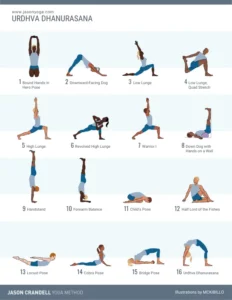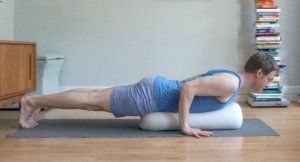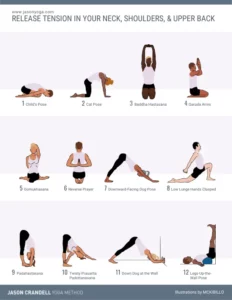Urdvha Dhanurasana is such an iconic pose, teachers around the world simply call it “backbend.” There’s no other posture like this. If your teacher said “OK everyone: arm balance,” would you have any idea which pose to do? No. What if they said, “OK everyone: twist,” or, “standing pose,” “forward bend,?” Nope.
Upward Bow represents an entire posture group—and is so ubiquitous in all current traditions of yoga—because it’s so thorough. It stretches the quads, hip-flexors, abdominals, and shoulders while strengthening the entire back body. The postures also engenders a debate about whether or not students should engage the gluteals. Here’s my take on the discussion.
HOW TO USE THIS BLOG
There are 3 ways to use this blog:
1. You can simply practice Urdhva Dhanurasana using the illustration above.
2. You can learn the steps get into the posture in the “How To” section.
3. Or you can geek out on the sequencing and anatomy details by skipping down to Part II.
Don’t forget to pass this along to your students and colleagues!
If you want to learn more, join me at my 500-hour Certification Program or for my Sequencing and Managing Yoga Injuries courses.
Yes, most students benefit from moderately engaging their gluteus maximus in Upward Bow. Your glutes extend your hip joint—which is what gives you the ability to lift into the pose. I understand why some teachers have concerns about using the glutes in this posture, so let me give you three conditions to ensure that engaging your gluteus maximus is beneficial: 1) Focus on engaging the lower part of the gluteus maximus near your hamstring attachments. 2) Simultaneously engage your adductors (inner leg muscles) so that your thighs don’t externally rotate when your glutes kick in. 3) Don’t engage your gluteus maximus so intensely that the contraction pushes your pelvis too far up into the posture. This can hyperextend your lower back and produce excessive compression. To summarize: a little bit of firmness without going crazy is a very good idea.
WARM UP
The most important parts of your body to warm up for Upward Bow are your quads and hip flexors. Several Low Lunge Sun Salutations, Low Lunge Quad Stretch, Supta Virasana and King Arthur’s Pose work best. If you’re unfamiliar with King Arthur’s Pose, here’s a tutorial. To warm your spine, try a simple progression of backbends that include Cobra Pose, Bow Pose (on your belly), and Bridge Bose. Shoulder openers like Gomukhasana and Garudasana help prepare the upper body for this backbend. If Handstand is part of your repertoire, include it in your preparations.
HOW-TO-DO URDHVA DHANURASANA (UPWARD FACING BOW POSE)
1. Lie back with your feet hip width and your hands slightly wider than your shoulders.
2. Take a slow, deep, “everything is going to be alright” breath.
3. Gently press your lower back into the floor and lift your tailbone. Initiating the pose this way will help your pelvis rotate the correct direction in the pose and minimize compression in your lower back. Continue lifting your up through your tailbone as you proceed through the following instructions.
4. As you inhale, press down through your hands and feet, lift your body slightly off the floor, and place the top of your head on floor. Bring awaress to your feet and press down through your big toes and inner heels—this will help minimize the tendency for the feet to splay outward in the pose. Take a moment to hug your elbows toward each other so that your elbows stay shoulder-width apart.
5. As you exhale, press your hands and feet more firmly into the floor and use this strength to raise your body into the posture.
6. Now that you’re in Upward Bow, check out the infographic above and refine your pose. Give yourself 3 to 5 breaths here and repeat the pose a few times.
7. It’s tempting to quickly bail out of the pose as soon as you’re done with it. Instead, practice lowering slowly to the floor. In fact, try to lower down one vertebra at a time. Slowing your descent in this posture will strenghten your shoulders, strengthen you abdominal core, and help decompress your lower back.
8. Take a moment or two after the pose and savor the sensations of your body. If you’re like me, your favorite part of Upward Bow is the moment you’re done.
IF I CAN’T DO UPWARD BOW YET, WHAT SHOULD I DO INSTEAD?
There are many, many reasons that Upward Bow can be innaccessible. If you’re unable to do Upward Bow, it may be due to lack of mobility or lack of strength. It’s also possible that you have discomfort in your wrists, shoulders, or knees that’s holding you back. Your best bet is to do a combination of postures that address all of these factors. Practice Cobra, Bridge Pose, and Reclined Backbend over a block for your spine and shoulders; practice Low Lunge Sun Salutations and King Arthur’s Pose to open your shoulders; and, practice Handstand (or Half-Handstand with your feet at the wall) to develop strength. If your wrists are uncomfortable in Handstand/Half-Handstand, practice Dolphin Pose instead.
PART II: ANATOMY AND SEQUENCING FOR URDHVA DHANURASANA
WHICH MUSCLES DOES URDHVA DHANURASANA STRENGTHEN?
Upward Bow strengthens all the posterior muscles of your body, the top of your shoulders, and the back of your arms. Here’s a more detailed look:
Your hamstrings and glutes
Your hamstrings and gluteus maximus work together to extend your hips. Find the sweet spot where you’re using just enough gluteal muscle to exend your hip without gripping so much that you externally rotate your femurs.
Your adductors
Your adductors are working to balance the effort of your gluteus maximus. By engaging your adductors, especially your adductor magnus, you will help keep your thighs parallel in the pose.
Your spinal muscles
All of your spinal muscles work to extend your spine.
Your shoulders
Your external rotators—infraspinatus, teres minor, and posterior deltoids—all engage to keep your upper arms externally rotated in the pose; your deltoids work to flex your shoulders; your serratus anterior laterally rotates your shoulder blades.
Your arms
Your triceps contract to straighten your arms.
WHICH MUSCLES DOES URDHVA DHANURASANA STRETCH?
Upward Bow stretches all the anterior muscles of your body. Here’s a more detailed look.
Your quadriceps
All of your quadriceps stretch in Upward Bow Pose. Of course, these muscles also contract to help straighten your knees which makes it more challenging for these muscles to simultaneously stretch. If you’re using your hamstrings, glutes, and adductors properly to support the weight of your pelvis, your quads don’t have to work as hard and they will stretch more effectively.
Your hip flexors
Your hip flexors—iliopsoas and rectus femoris—stretch in Upward Bow.
Your abdominals
Your abdominals stretch—especially your rectus abdominis. You may also get a mild stretch in your intercostal muscles.
Your chest and shoulders
Your latissimus dorsi, pectoralis major, and pectoralis minor all stretch in Upward Bow.
SEQUENCING FOR URDVHA DHANURASANA
You can find a fully-illustrated, 16-pose Urdvha Dhanurasana sequence here.
{illustration by MCKIBILLO}





